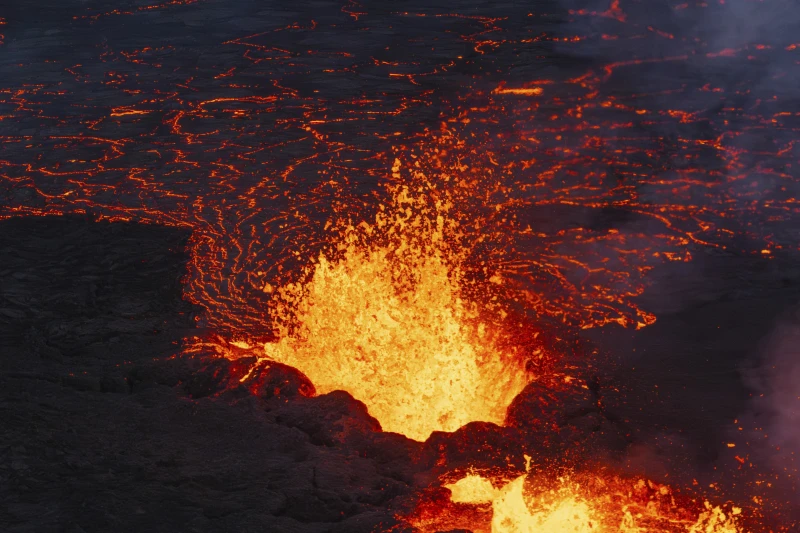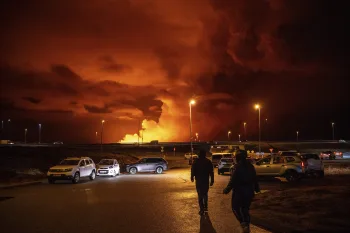The recent volcanic eruption in Iceland, specifically in the region of Grindavik, has once again thrust the captivating and tumultuous power of nature into the forefront of our collective consciousness.
This eruption, the fourth within a span of three months, unfolded on a Saturday evening, painting the night sky with mesmerizing hues of orange as lava cascaded from the earth’s depths.
The Icelandic Meteorological Office, tasked with monitoring such geological phenomena, revealed that the eruption had birthed a formidable fissure stretching approximately 3 kilometers, nestled between the imposing Stóra-Skógfell and Hagafell mountains on the Reykjanes Peninsula.
The ominous signs leading up to this event had been evident, with the Met Office issuing warnings of accumulating magma, a precursor to the inevitable eruption that eventually transpired.
As the molten rock surged forth from the bowels of the earth, a swift and coordinated evacuation effort was initiated, ensuring the safety of hundreds of individuals, including visitors at the renowned Blue Lagoon thermal spa, a cherished gem in Iceland’s tourism landscape.
The evacuation, though necessary, underscored the potential dangers posed by such natural occurrences, serving as a stark reminder of the fragile coexistence between human settlements and the volatile forces that lie dormant beneath the Earth’s surface.
Despite the dramatic spectacle unfolding in the vicinity, the eruption did not disrupt the operations of Keflavik, Iceland’s primary airport, a testament to the resilience and adaptability of the region’s infrastructure in the face of adversity.
The eruption site, located a short distance northeast of Grindavik, a coastal town that had already weathered previous evacuations in December, once again found itself at the mercy of nature’s capricious temperament.
The swift re-evacuation of residents who had returned to their homes underscored the unpredictable nature of volcanic activity and the need for constant vigilance in regions prone to such phenomena.
The proximity of Grindavik to Iceland’s capital, Reykjavik, serves as a poignant reminder of the interconnectedness of human settlements and the natural environment, a delicate balance that must be respected and preserved.
The resilience and fortitude exhibited by the residents of Grindavik and neighboring areas in the face of recurrent eruptions exemplify the indomitable spirit of communities confronted with the raw power of nature.
In conclusion, the recent volcanic eruption in Iceland stands as a testament to the awe-inspiring yet formidable forces that shape our planet.
It serves as a poignant reminder of the impermanence of human constructs in the face of nature’s unfathomable might, urging us to approach the natural world with humility, respect, and a deep-seated appreciation for its intrinsic beauty and power.
In the annals of natural disasters, the awakening of the Svartsengi volcanic system in Grindavik stands out as a stark reminder of the raw power and unpredictability of Mother Nature.
Evacuated in November after centuries of dormancy, the town bore witness to a series of seismic tremors that heralded the awakening of a slumbering giant beneath its very foundations.
As the earth cracked open and lava surged forth, the residents of Grindavik faced a trial by fire unlike any other in recent memory.
On December 18, the volcano unleashed its fury upon the land, spewing forth rivers of molten rock that flowed away from Grindavik, sparing the town from immediate destruction.
However, the respite was short-lived, as a second eruption on January 14 sent a fiery tide hurtling towards the town.
Despite the valiant efforts of defensive walls erected after the first eruption, several buildings succumbed to the relentless advance of the lava, leaving a trail of destruction in their wake.
As the eruptions continued to ravage the landscape, a third outburst on February 8 brought fresh chaos and devastation to Grindavik.
Although short-lived, this eruption proved to be the most powerful yet, unleashing a river of lava that engulfed a vital pipeline, cutting off heat and hot water to thousands of residents.
The ominous words of geophysicist Magnús Tumi Guðmundsson echoed through the air, underscoring the gravity of the situation as lava crept ever closer to the defensive barriers surrounding the beleaguered town.
Iceland, perched atop a volcanic hot spot in the turbulent waters of the North Atlantic, is no stranger to the capricious whims of its geothermal heart.
With a history punctuated by regular eruptions, the island nation has honed its expertise in dealing with the fiery specter of volcanic activity.
The specter of the 2010 Eyjafjallajokull eruption looms large in the collective memory, a stark reminder of the havoc that nature can wreak upon the modern world.
Amidst the chaos and destruction wrought by the recent eruptions in Grindavik, a testament to the resilience and fortitude of its inhabitants emerges.
Despite the loss of property and infrastructure, no confirmed deaths have been reported thus far, a testament to the swift and coordinated response of emergency services and the indomitable spirit of the townspeople.
However, amidst the tales of survival and heroism, a somber note lingers as a workman remains missing, lost to the gaping maw of a fissure torn open by the volcanic upheaval.
As the embers of the recent eruptions smolder and the town of Grindavik begins the arduous task of rebuilding and recovery, the enduring spirit of its people shines forth as a beacon of hope amidst the darkness.

The trials and tribulations faced by the town serve as a stark reminder of the fragility of human existence in the face of nature’s wrath, yet also stand as a testament to the resilience and courage that define us in times of crisis.
Grindavik may have been tested by fire and fury, but in its crucible, a community united in adversity emerges stronger and more resilient than ever before.
In the shadow of the smoldering volcano, the people of Grindavik stand tall, their spirits unbroken and their resolve unwavering.
As they look towards the future, scarred but unbowed, they carry with them the lessons learned from the crucible of disaster, forging a path forward guided by the light of hope and the strength of community.
The tale of Grindavik is not merely one of destruction and despair, but of survival and renewal—a testament to the enduring power of the human spirit in the face of adversity.
